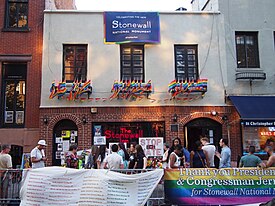Lesbian culture
| LGBT culture | |

The Stonewall Inn in the gay village of Greenwich Village, Manhattan, site of the June 1969 Stonewall riots, the cradle of the modern LGBT rights movement and an icon of LGBT culture, is adorned with flags depicting the colors of the rainbow.
|
LGBT culture is a culture shared by lesbian, gay, bisexual, transgender, questioning, and intersex people. It is sometimes referred to as queer culture (indicating people who are queer), while the term gay culture may be used to mean "LGBT culture," or to refer specifically to homosexual male culture.
LGBT culture varies widely by geography and the identity of the participants. Elements common to cultures of gay, lesbian, bisexual, transgender and intersex people include:
Not all LGBT people identify with LGBT culture; this may be due to geographic distance, unawareness of the subculture's existence, fear of social stigma or a preference for remaining unidentified with sexuality- or gender-based subcultures or communities. The Queercore and Gay Shame movements critique what they see as the commercialization and self-imposed "ghettoization" of LGBT culture.
In some cities, especially in North America, some LGBT people live in neighborhoods with a high proportion of gay residents, otherwise known as gay villages or gayborhoods. Such LGBT communities organize special events in addition to pride parades celebrating their culture such as the Gay Games and Southern Decadence.
According to Herdt, "homosexuality" was the main term used until the late 1950s and early 1960s; after that, a new "gay" culture emerged. "This new gay culture increasingly marks a full spectrum of social life: not only same-sex desires but gay selves, gay neighbors, and gay social practices that are distinctive of our affluent, postindustrial society".
During the 19th and early 20th centuries gay culture was covert, relying on secret symbols and codes woven into an overall straight context. Gay influence in early America was primarily limited to high culture. The association of gay men with opera, ballet, couture, fine cuisine, musical theater, the Golden Age of Hollywood and interior design began with wealthy homosexual men using the straight themes of these media to send their own signals. In the heterocentric Marilyn Monroe film Gentlemen Prefer Blondes, a musical number features Jane Russell singing "Anyone Here for Love" in a gym while muscled men dance around her. The men's costumes were designed by a man, the dance was choreographed by a man and the dancers (as gay screenwriter Paul Rudnick points out) "seem more interested in each other than in Russell"; however, her presence gets the sequence past the censors and works it into an overall heterocentric theme.
...
Wikipedia
